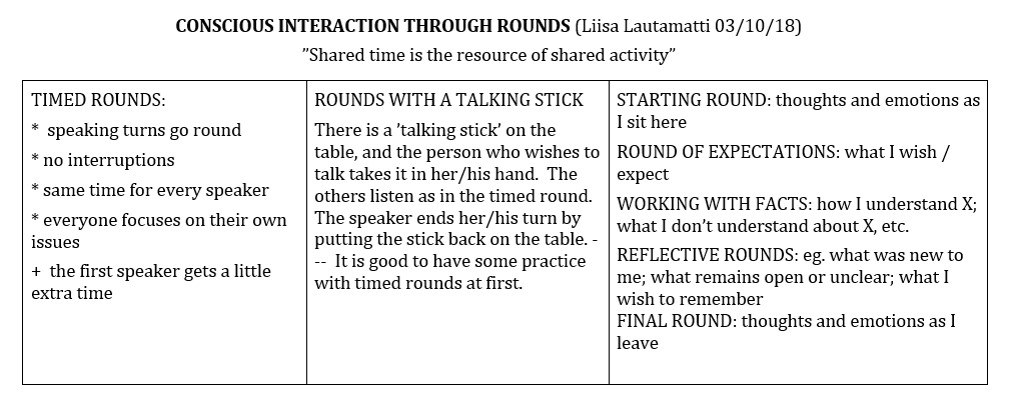Learning in and about groups COPY
LEARNING OUTCOMES: After the module the learner will
- understand the potential and possibilities of small groups and peer groups in university teaching and learning
- be able to apply the understanding of group learning in own teaching practices
- increase self-knowledge as a facilitator of group learning through self-reflection
- be able to critically reflect own position in small group and peer group situations
Content: Social dimensions of small and peer groups; Group learning in experiential learning theories; Starting small or peer group learning; Creating safe atmosphere; Teacher as a facilitator of group learning; Self-reflection as a facilitator
Self-study materials
Welcome to study the module of small groups in learning!
Here is a structure for the self-study of this module.
Task 1. Self-reflection
a) Draw your lifeline on a paper. Mark the 3-5 most significant experiences as a teacher on the lifeline - positive or negative. Describe them in writing. HOW DOES THIS RELATE TO THE SMALL GROUPS IN LEARNING???
b) Write a short reflection on experiences as facilitating small group learning and/or being a learner in a small group. What are the main points or key elements that you can find in your experience?
Task 2. TEEMA
Watch the first video on
After the video write a reflection on your own
Task 3. TEEMA
ohjeet
Task 4. Safety
ohjeet
Task 5. TEEMA
ohjeet



- Bion, W. R. 1961. Experiences in groups and other papers. London: Routledge.
- Borg, M., Kembro, J., Pedersen Notandera, J., Petersson, C., Ohlsson, L. 2011. Conflict Management in Student Groups - a Teacher’s Perspective in Higher Education. Högre utbildning, 1 (2), 111-124.
- Brookfield, S. 2006. The skillful teacher: on technique, trust, and responsiveness in the classroom. San Francisco: Jossey-Bass.
- Burke, A. 2011. Group Work: How to Use Groups Effectively. The Journal of Effective Teaching, 11 (2), 87-95.
- Davidson, N., Major, C. H. & Michaelsen, L. K. 2014. Small-group learning in higher education—cooperative, collaborative, problem-based, and team-based learning: An introduction by the guest editors. Journal on Excellence in College Teaching 25 (3&4), 1-6.
- Estébanez, R. P. 2017. An Approachment to Cooperative Learning in Higher Education: Comparative Study of Teaching Methods in Engineering. EURASIA Journal of Mathematics Science and Technology Education, 13 (5), 1331-1340.
- Haapaniemi, R. & Raina, L. 2014. Rakenna oppiva ryhmä. Pedagogisen viihtymisen käsikirja. Jyväskylä: PS-kustannus.
- Kopakkala, A. 2011. Porukka, jengi, tiimi. Ryhmädynamiikka ja siihen vaikuttaminen. Helsinki.
- Mills, D. & Alexander, P. 2013. Small group teaching: a toolkit for learning. The Higher Education Academy.
- Niemistö, R. 1998. Ryhmän luovuus ja kehitysehdot. Tampere: Tammerpaino.
- Nikkola, T. 2011. Oppimisen esteet ja mahdollisuudet ryhmässä. Syyllisyyden kehittyminen syntipukki-ilmiöksi opiskeluryhmässä ohjaajan tulkitsemana. Jyväskylä Studies in Education, Psychology and Social Research 422.
- Nummenmaa, A. R. & Lautamatti, L. 2004. Ohjaajana opinnäytetöiden työprosesseissa. Ryhmäohjauksen käytäntöä ja teoriaa. Tampere: Tampere University Press.
- Repo-Kaarento, S. 2007. Innostu ryhmästä. Helsinki: Kansanvalistusseura. Topping, K. J. 2005. Trends in Peer Learning. Educational psychology, 25 (6), 631-645.
- Topping, K. J. 2005. Trends in Peer Learning. Educational psychology, 25 (6), 631-645.
Contact your own University for information regarding guided studies based on the materials.
THE MODULE CREATED BY UNIPS
Specialists: Anita Malinen, University of Jyväskylä, Juha Lahti, University of Jyväskylä, Terhi Skaniakos, University of Jyväskylä.
Video and audio production: Kari Toiviainen, University of Jyväskylä, Ville Vester, University of Jyväskylä.

 This work is licensed under a Creative Commons Attribution-ShareAlike 4.0 International License.
This work is licensed under a Creative Commons Attribution-ShareAlike 4.0 International License.
